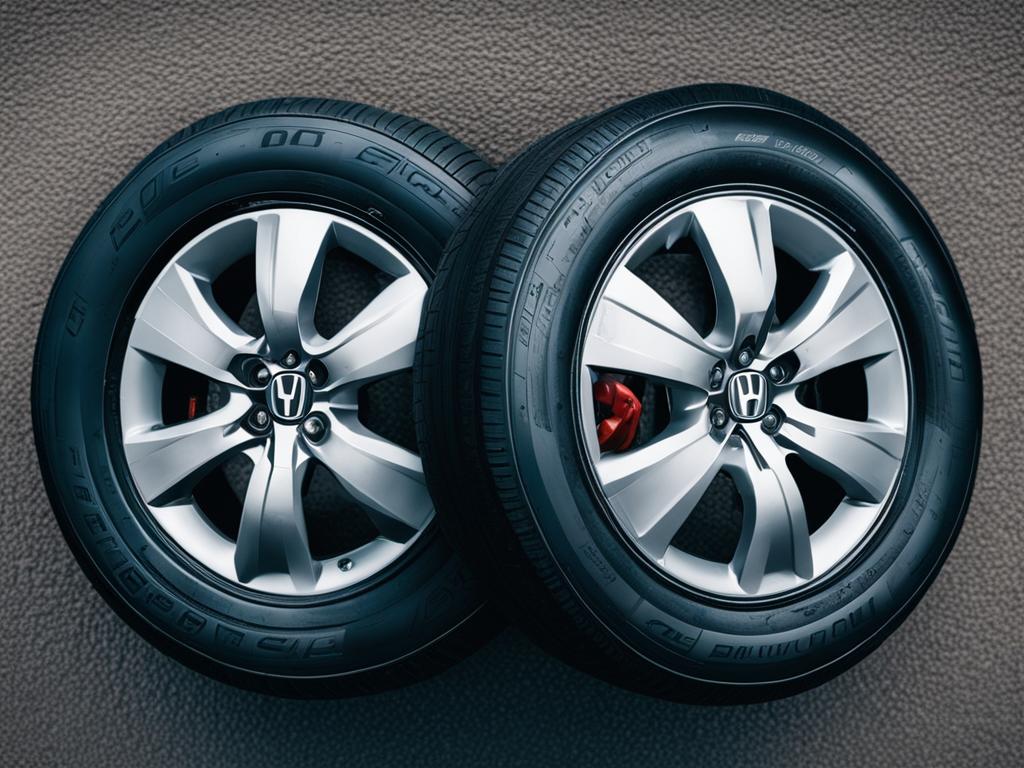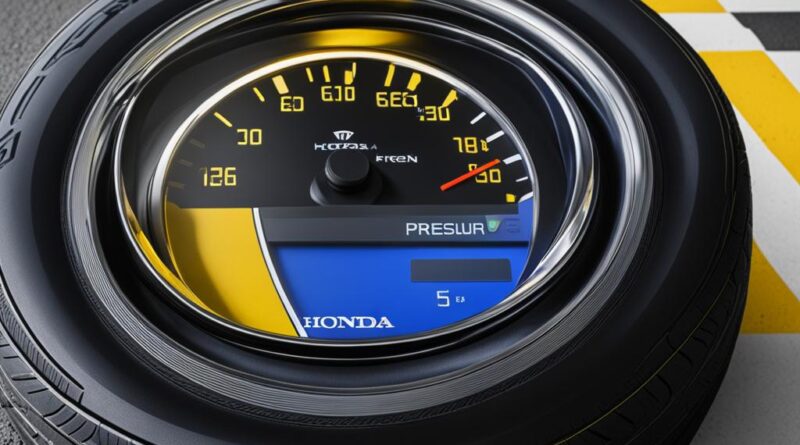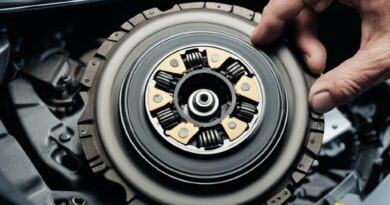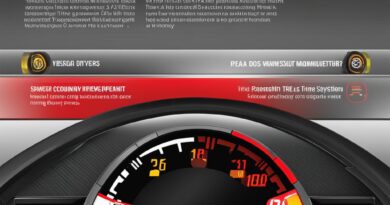Honda Civic Tire Pressure Guide & Tips
When it comes to maintaining your Honda Civic, keeping an eye on the tire pressure is crucial. Proper tire pressure not only ensures your safety on the road but also contributes to the optimal performance of your vehicle. In this guide, we’ll explore the recommended tire pressure for a Honda Civic, how to check the tire pressure, and the importance of maintaining the right tire pressure. We’ll also provide helpful tips to help you keep your Honda Civic’s tires in top condition.
Key Takeaways:
- Recommended tire pressure for a Honda Civic is around 32 psi for both front and rear tires.
- A Tire Pressure Monitoring System (TPMS) is installed in the Honda Civic to alert the driver of low tire pressure.
- Regularly check the tire pressure using a gauge and adjust it accordingly for optimal performance.
- Maintaining the right tire pressure improves safety, handling, fuel efficiency, and tire longevity.
- Inspect your tires for signs of damage or wear and address any low tire pressure warnings promptly.
How to Check Tire Pressure on Honda Civic
Checking the tire pressure on your Honda Civic is a simple yet essential task to ensure optimal performance and safety. By following these steps, you can easily monitor and maintain the correct tire pressure for your vehicle.
Step 1: Gather the Necessary Tools
To check the tire pressure on your Honda Civic, you’ll need a tire pressure gauge. This tool allows you to measure the air pressure inside the tires accurately. Make sure you have a gauge that is compatible with your Civic’s tire valve stems.
Step 2: Remove the Valve Stem Caps
Start by removing the valve stem caps on each tire. These caps protect the valve from dust and debris. Place them in a safe location to ensure they don’t get misplaced during the process.
Step 3: Use the Tire Pressure Gauge
Press the tire pressure gauge firmly onto the valve stem of the first tire. Hold it in place until you hear a hissing sound, indicating that the gauge has made a good seal. After a second or two, the gauge will display the current tire pressure reading.
Step 4: Record the Tire Pressure
Take note of the tire pressure reading for each tire. Repeat the process for the remaining three tires, ensuring that you use the same pressure gauge for consistency.
Step 5: Compare with Recommended Tire Pressure
Refer to the owner’s manual or the sticker located on the driver’s side door frame for the recommended tire pressure for your specific Honda Civic model. Compare the recorded tire pressure readings with the recommended values. If any tire has lower pressure than the recommended level, it may require inflation.
Step 6: Add Air if Necessary
If you find that a tire has low pressure, you can add air to it to reach the recommended level. You can use an air compressor at home or visit a nearby gas station with an air pump. Repeat the process of checking the tire pressure after inflating to verify that it matches the recommended level.
Remember, overinflating the tires is not recommended, as it can lead to reduced traction and uneven tire wear. Always aim to maintain the recommended tire pressure for a safe and comfortable driving experience.
Optimal Tire Pressure for Honda Civic
The optimal tire pressure for a Honda Civic can vary depending on the specific model and tire size. It is important to maintain the optimal tire pressure to ensure proper handling, fuel efficiency, and tire longevity. If the tire pressure is too high or too low, it can negatively impact the vehicle’s performance and safety.
To determine the optimal tire pressure for your Honda Civic, refer to the owner’s manual or the sticker located on the driver’s side door frame. This information can also be found in the vehicle’s tire placard. These sources will provide the recommended tire pressure specific to your Civic.
Proper tire pressure is crucial for optimal handling. When the tire pressure is too low, it can lead to decreased stability and compromised maneuverability. On the other hand, overinflated tires can result in a harsh ride and reduced traction.
Maintaining the recommended tire pressure also enhances fuel efficiency. Underinflated tires create more rolling resistance, which leads to increased fuel consumption. By keeping the tire pressure at the optimal level, you can maximize your Honda Civic’s fuel economy.
Additionally, proper tire pressure contributes to tire longevity. Overinflated or underinflated tires can wear unevenly, reducing their lifespan. By maintaining the optimal tire pressure, you can help ensure even tire wear and prolong the life of your tires.
The Honda Civic is equipped with a tire pressure monitoring system (TPMS) that includes a tire pressure indicator. This indicator will display a warning light on the dashboard if the tire pressure is outside the recommended range. If the tire pressure light illuminates, it is essential to address the issue promptly by checking the tire pressure and adjusting it as necessary.

Overall, maintaining the optimal tire pressure for your Honda Civic is crucial for safety, performance, and fuel efficiency. Refer to the recommended tire pressure guidelines provided by the manufacturer, regularly check the tire pressure, and make adjustments as needed. By doing so, you can enjoy a smooth and safe driving experience with your Honda Civic.
Importance of Maintaining the Right Tire Pressure for Honda Civic
Maintaining the right tire pressure is essential for the safety and performance of your Honda Civic. Proper tire pressure improves maneuverability, stability, and reduces braking distances. It also helps prevent tire blowouts and reduces the risk of hydroplaning. In addition to safety, maintaining the right tire pressure can also improve fuel efficiency. Underinflated tires create more rolling resistance, resulting in decreased fuel efficiency. Overinflated tires can cause poor vehicle handling and uneven tire wear.
It is important to regularly check and adjust the tire pressure to the recommended levels to ensure optimal performance and safety for your Honda Civic.
Proper tire pressure plays a significant role in enhancing your driving experience and extending the lifespan of your tires. By keeping the tire pressure at the recommended level, you can enjoy a smooth and comfortable ride, while also reducing the risk of unexpected tire issues.
“Proper tire pressure improves maneuverability, stability, and reduces braking distances.”
When tire pressure is too low, the tire’s surface area in contact with the road increases, leading to increased friction and heat generation. This can cause the tires to wear out quickly and be more susceptible to damage. On the other hand, overinflated tires have a smaller contact patch, reducing traction and compromising safety.
The Honda Civic is equipped with a tire pressure monitoring system (TPMS) that helps you keep track of the tire pressure. The TPMS alerts you when the tire pressure is outside the recommended range, ensuring you can take prompt action to adjust the pressure as needed.
Regularly checking and maintaining the right tire pressure ensures that your Honda Civic performs optimally, enhances fuel efficiency, and provides a safer driving experience for you and your passengers.
Image:
Tips for Maintaining Proper Tire Pressure on Honda Civic
Proper tire pressure is essential for the safety and performance of your Honda Civic. Here are some tips to help you maintain optimal tire pressure:
- Regularly check the tire pressure using a tire pressure gauge. This will ensure that your tires are inflated to the correct level.
- Check the tire pressure when the tires are cold, as heat can cause an increase in pressure.
- Inflate or deflate the tires to the optimal pressure recommended for your specific model of Honda Civic. The recommended tire pressure can be found in the owner’s manual or on the sticker located on the driver’s side door frame.
- Inspect the tires for any signs of damage or wear, such as cuts, bulges, or uneven tread wear. Address any issues promptly to prevent further damage and maintain optimal tire pressure.
- If the tire pressure light illuminates on the dashboard, it indicates that the tire pressure is outside the recommended range. Check the tire pressure and adjust as necessary.
- Consider investing in a portable air compressor. This will allow you to easily inflate the tires when needed, ensuring that they are always at the optimal pressure.
By following these tips, you can ensure that your Honda Civic maintains the optimal tire pressure for safe and efficient driving.

Conclusion
Maintaining the proper tire pressure is crucial for the safety and performance of your Honda Civic. By regularly checking and adjusting the tire pressure to the recommended levels, you can ensure optimal handling, fuel efficiency, and tire longevity. The Honda Civic is equipped with a tire pressure monitoring system that alerts the driver if the tire pressure is too low. It is essential to address any low tire pressure warnings promptly and make necessary adjustments.
By following the recommended tire pressure guidelines for your specific model of Honda Civic, you can enjoy a smooth and safe driving experience. The optimal tire pressure for a Honda Civic may vary depending on the specific model and tire size. It is recommended to refer to the owner’s manual or the sticker located on the driver’s side door frame for the specific tire pressure for your Civic. This information can also be found in the vehicle’s tire placard.
Remember, maintaining the right tire pressure not only enhances safety but also improves fuel efficiency and extends tire life. Proper tire pressure improves maneuverability, stability, and reduces braking distances. It helps prevent tire blowouts and reduces the risk of hydroplaning. By taking the time to check and adjust your Honda Civic’s tire pressure regularly, you are prioritizing your safety and ensuring optimal performance on the road.
FAQ
What is the recommended tire pressure for a Honda Civic?
The recommended tire pressure for a Honda Civic is around 32 psi for both the front and rear tires.
How do I check the tire pressure on my Honda Civic?
To check the tire pressure on a Honda Civic, you can use a tire pressure gauge. Remove the valve stem cap on each tire and press the gauge onto the valve stem to get a reading of the current tire pressure.
What is the optimal tire pressure for a Honda Civic?
The optimal tire pressure for a Honda Civic varies depending on the specific model and tire size. It is recommended to refer to the owner’s manual or the sticker located on the driver’s side door frame for the specific tire pressure for your Civic.
Why is maintaining the right tire pressure important for a Honda Civic?
Maintaining the right tire pressure is important for a Honda Civic as it improves maneuverability, stability, reduces braking distances, prevents tire blowouts, reduces the risk of hydroplaning, improves fuel efficiency, and ensures optimal performance and safety.
How can I maintain proper tire pressure on my Honda Civic?
Here are some tips for maintaining proper tire pressure on your Honda Civic:
– Regularly check the tire pressure using a tire pressure gauge.
– Check the tire pressure when the tires are cold.
– Inflate or deflate the tires to the optimal pressure recommended for your specific model of Honda Civic.
– Inspect the tires for any signs of damage or wear.
– Address any low tire pressure warnings promptly.
– Consider investing in a portable air compressor to easily inflate the tires when needed.
What are some benefits of maintaining the proper tire pressure on a Honda Civic?
Maintaining the proper tire pressure on a Honda Civic offers benefits such as improved handling, fuel efficiency, tire longevity, and overall safety while driving.




